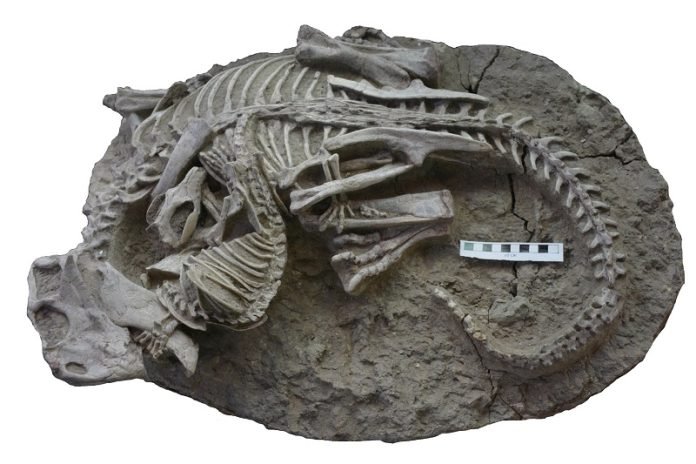
In an extraordinary find, Canadian and Chinese scientists have unearthed an incredibly well-preserved fossil from approximately 125 million years ago.
This remarkable discovery captures a moment frozen in time when a carnivorous mammal engaged in a life-or-death struggle with a much larger plant-eating dinosaur.
The fossil provides one of the first glimpses into the predatory behavior of mammals towards dinosaurs during the Cretaceous period, dispelling the notion that dinosaurs faced little threat from their mammalian contemporaries.
This exceptionally rare fossil now resides in the Weihai Ziguang Shi Yan School Museum in China’s Shandong Province.
The fossil features a dinosaur identified as a species of Psittacosaurus, roughly the size of a large dog.
Psittacosaurs were among the earliest known horned dinosaurs and roamed Asia during the Early Cretaceous period, between 125 and 105 million years ago.
Engaged in a fierce battle with the dinosaur is a badger-like mammal known as Repenomamus robustus.
Although not gigantic by dinosaur standards, Repenomamus was one of the largest mammals of its time when mammals had yet to dominate the Earth.
Previously, paleontologists had inferred Repenomamus’s predatory behavior toward dinosaurs based on fossilized baby dinosaur bones found in the mammal’s stomach.
Dr. Jordan Mallon, a paleobiologist from the Canadian Museum of Nature and co-author of the study published in Scientific Reports, explains, “The coexistence of these two animals is not new, but what’s new to science through this amazing fossil is the predatory behavior it shows.”
Discovered in China’s Liaoning Province in 2012, the near-complete skeletons of both animals offer invaluable insights. The fossils originated from the Liujitun fossil beds, commonly referred to as “China’s Dinosaur Pompeii.” This area earned its nickname due to the plethora of fossils, including dinosaurs, small mammals, lizards, and amphibians, preserved by sudden mudslides and volcanic eruptions.
Confirming the presence of volcanic material in the fossil’s rock matrix, Canadian Museum of Nature mineralogist Dr. Aaron Lussier further authenticated the find.
Dr. Gang Han, the Chinese researcher who possessed the Psittacosaurus-Repenomamus fossil, shared the discovery with Dr. Xiao-Chun Wu, a paleobiologist at the Canadian Museum of Nature.
Careful examination of the fossilized pair reveals the Psittacosaurus lying motionless, hindlimbs folded alongside its body. The Repenomamus curls around the dinosaur’s right side, perched triumphantly atop its prey, with its jaws tightly gripping the larger dinosaur’s jaw.
The mammal is also seen biting into the ribs, while its hind foot clings to the dinosaur’s hind leg. Dr. Mallon suggests, “The weight of the evidence suggests that an active attack was underway.”
To dismiss the possibility of scavenging, Mallon, Wu, and their colleagues noted the absence of tooth marks on the dinosaur’s bones, indicating that it was not being scavenged.
Moreover, the intricate entanglement of the two animals suggests that the dinosaur was not already deceased when the mammal encountered it. The positioning of the Repenomamus over the Psittacosaurus indicates that it was the aggressor.
While it may seem unusual, there are parallels in the animal kingdom where smaller creatures attack larger prey. For instance, lone wolverines have been known to hunt larger animals like caribou and domestic sheep.
On the African savanna, wild dogs, jackals, and hyenas frequently launch attacks on live prey, causing the prey to collapse in a state of shock.
Dr. Mallon speculates, “This might be the case depicted in the fossil, with the Repenomamus actually consuming the Psittacosaurus while it was still alive—before both were tragically swept away by the aftermath of volcanic activity.”
The research team predicts that the Lujiatun fossil beds’ volcanic deposits will continue to yield further evidence of interactions between species, shedding light on previously unknown aspects of the fossil record.
Follow us on Twitter for more articles about this topic.
Source: Canadian Museum of Nature.



